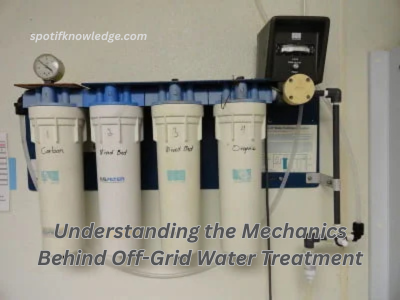Off-grid water treatment turns remote living from a survival exercise into a reliable routine. At its core are straightforward physical and biological principles—pressure, flow, contact time, and microbial ecology—woven into compact systems that run on solar, wind, or human power.
Understanding these mechanics helps you size equipment realistically, keep water quality stable through seasonal changes, and avoid pitfalls such as biofouling, turbidity spikes, or under-disinfection.
Source Capture and Pre-Filtration
Everything begins at the source: rainwater, springs, shallow wells, or surface intakes. Hydraulically, the priority is gentle conveyance so sediment stays put. Leaf screens, first-flush diverters, and mesh strainers remove the big offenders—grit, organics, and roof debris—so downstream media do not clog prematurely.
A modest gravity head can move water into a settling barrel, where velocity drops and particles fall out. When fines persist, a simple dose of alum or plant-based flocculants helps tiny colloids clump so they settle or filter more easily. Protecting catchment surfaces and shading storage tanks reduces algae before it starts.
Pressure, Flow, and Contact Time
After coarse cleaning, performance depends on matching pressure and flow to each stage, so contact time is never an afterthought. Cartridge or sand filters prefer steady, moderate flow to prevent channeling; activated carbon demands slower passage to adsorb tastes, odors, and residual organics.
In UV systems, dose equals lamp intensity multiplied by exposure time, so a flow restrictor ensures pathogens receive enough light even when gravity wants to rush. For chlorine or hypochlorite, baffled chambers and serpentine piping create residence time and thorough mixing, while simple test kits verify a safe residual at the tap.
Membranes and Biological Processes
Membrane elements—microfiltration, ultrafiltration, and reverse osmosis—use pressure differentials to push water through tiny pores while rejecting pathogens and salts. Stable flux requires pretreatment, antiscalants where appropriate, and periodic backwash, plus respect for recovery limits so minerals do not crystallize inside the module.
Where power is scarce, slow-sand filters harness biology instead: a living schmutzdecke forms on the surface and metabolizes pathogens and nutrients as water percolates. Biofilters reward patience; lower flow preserves oxygen, while occasional scraping of the top layer resets performance without chemicals.
Distribution, Storage, and Energy Balancing
Clean water still needs safe movement and storage. Elevated tanks create dependable pressure without continuous power, while foot valves, nonreturn valves, and air-release points preserve prime and prevent air locking. Pipe diameters are selected to keep velocities moderate, trimming friction losses, noise, and the risk of negative-pressure ingress.
In rugged settings, custom pumps can match unusual suction lifts, variable heads, or intermittent energy profiles. Finally, basic sensors and a simple logbook track turbidity, residual disinfectant, and daily volumes so maintenance happens on schedule rather than after failure.
Conclusion
Off-grid treatment succeeds when physics, biology, and energy strategy pull in the same direction. Protect the source, meter flow, respect contact time, and monitor storage, and small systems can deliver big-city safety with countryside resilience. Done well, the result is dependable drinking water that keeps pace with weather, seasons, and everyday life, far from the grid. Read More

